7 Best Cloud-Connected Irrigation Controllers 2025
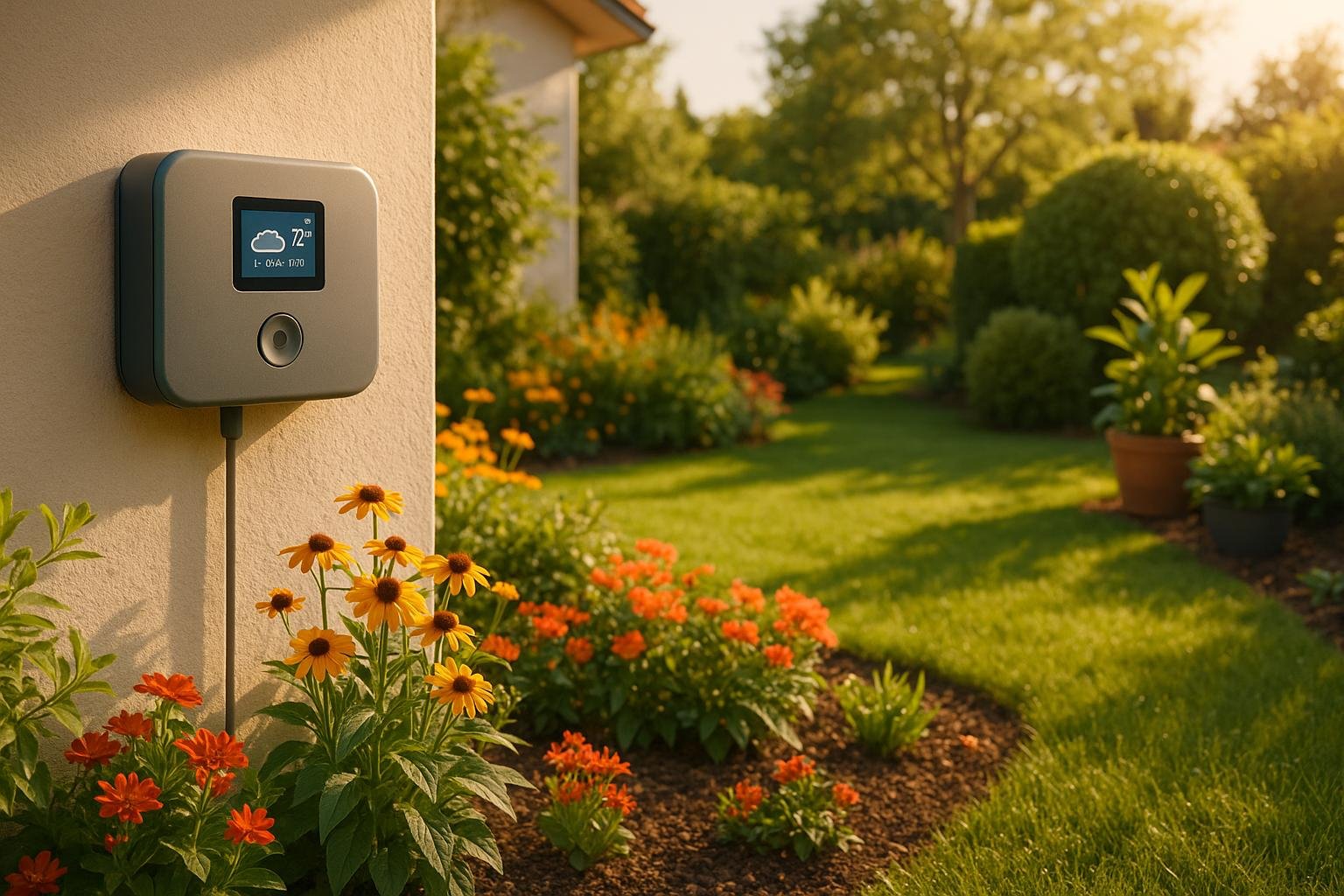
Looking for the best smart irrigation controllers for 2025? Here's everything you need to know to save water, reduce costs, and keep your plants healthy. These cloud-connected controllers use real-time weather data, soil moisture levels, and advanced zone management to deliver efficient, automated watering. Some even integrate with mobile apps and voice assistants for remote control.
Key Highlights:
- Top Picks: Rachio 3, Hunter Hydrawise HC-600i, Orbit B-hyve XR, RainMachine Touch HD Pro, Spruce Smart, Netro Sprite, and Rain Bird ARC8.
- Water Savings: Cut outdoor water use by 20%-50% with weather-based adjustments.
- Convenience: Manage schedules, monitor performance, and adjust settings remotely via apps.
- Zone Flexibility: Options range from 4 to 32 zones to suit different property sizes.
- Pricing: Starts as low as $62 for budget-friendly options and goes up to $250 for premium models.
Quick Comparison Table:
| Controller | Zone Options | Starting Price | Key Feature | Weather Integration |
|---|---|---|---|---|
| Rachio 3 | 4, 8, 16 zones | $199 (8-zone) | Advanced weather intelligence | Yes |
| Hunter HC-600i | 4–32 zones (modular) | $188 | Professional-grade durability | Yes |
| RainMachine Touch HD Pro | Multiple options | Not specified | Internet-independent operation | Yes |
| Spruce Smart | Varies | Not specified | Soil moisture sensors | Yes |
| Netro Sprite | 6, 12 zones | $99 (6-zone) | Plant-specific algorithms | Yes |
| Rain Bird ARC8 | 8 zones | Not specified | Freeze protection | Yes |
| Orbit B-hyve XR | 8, 16 zones | $160 (16-zone) | Budget-friendly smart features | Yes |
These smart irrigation controllers make watering smarter, easier, and more efficient. Whether you're managing a garden or a large property, there's a model to fit your needs and budget.
7 Smart Irrigation Systems TESTED: Buyers Guide

Key Features to Look for in Cloud-Connected Irrigation Controllers
When you're in the market for a cloud-connected irrigation controller, certain features can elevate your irrigation system from basic to highly efficient. These upgrades not only conserve water but also help maintain a thriving landscape. Let’s dive into some of the most impactful features, starting with weather integration.
Weather Integration and Smart Adjustments
Weather-based irrigation controllers (WBICs) rely on real-time weather data to optimize watering schedules. By calculating evapotranspiration (ET) - the water lost through soil evaporation and plant transpiration - these systems can automatically pause watering when rainfall meets your landscape’s needs. Thanks to their internet connectivity, smart controllers receive continuous weather updates, adjusting schedules dynamically to match changing conditions.
The potential savings are impressive. For instance, the Granite Park office complex in Dallas, Texas, installed a WaterSense-labeled WBIC and saved 12.5 million gallons of water in just one year. This 40% reduction translated into $47,000 in cost savings, with a payback period of only 1.5 years.
When evaluating weather-related features, pay attention to the source and accuracy of the data. Some controllers pull information from nearby weather stations, while others use on-site sensors for hyper-local readings - especially useful in areas with highly variable conditions. Also, opt for systems that don’t charge additional fees for accessing weather data.
"Implementing smart irrigation systems is a step towards efficient and sustainable water usage, combating global challenges like climate change and water scarcity." - Peter Pappas, Founder, P.J. Pappas Company
Zone Management and Scalability
Efficient irrigation starts with proper zone management. Professional landscapers design zones based on factors like plant water requirements, soil type, sunlight exposure, slope, and water pressure. This ensures that each area receives the right amount of water, avoiding overwatering in one zone while under-watering another. Additionally, converting lawn zones to xeriscaping can cut outdoor water use by 50–75%.
Scalability is just as important. Choosing a controller that supports more zones than you currently need gives you the flexibility to expand your system later without replacing the entire setup. Effective zone management pairs perfectly with modern mobile control, which we’ll explore next.
Mobile App and Voice Assistant Compatibility
Mobile app control brings convenience and flexibility to irrigation management. The best apps let you tweak schedules, monitor soil moisture in real time, and adjust watering based on weather updates. Many also send notifications about system performance and maintenance, keeping you informed and in control.
Voice assistant compatibility takes this convenience a step further. For example, the Rachio 3 Smart Sprinkler Controller works with Amazon Alexa, Google Home, and Siri Shortcuts. Similarly, the Orbit B-hyve XR Smart Indoor/Outdoor Sprinkler Timer supports both Alexa and Google Home, while the Netro Smart Sprinkler Controller and Hunter Hydrawise HPC-400 Outdoor Irrigation Controller also integrate with Alexa.
When assessing a controller’s app, test its user interface to ensure it’s intuitive and easy to use. A great system isn’t just about advanced features - it’s about making those features accessible through a reliable app backed by regular updates and responsive customer support.
7 Best Cloud-Connected Irrigation Controllers of 2025
These seven controllers stand out for their dependability, features, and ability to cater to various yard sizes, budgets, and technical preferences. Below, you’ll find a quick breakdown of each, highlighting the features that make them effective for smart irrigation.
Rachio 3 Smart Sprinkler Controller

The Rachio 3 continues to set the standard for residential smart irrigation, boasting a 4.7/5 rating from over 1,700 users. Its user-friendly app and precise weather integration simplify irrigation management. One standout feature is its flow monitoring, which detects issues like broken sprinkler heads or leaks and automatically shuts off water to avoid waste and damage. It also supports voice commands through Alexa, Google Home, and Siri Shortcuts.
"My favorite part is that Rachio uses weather intelligence. The app will recognize upcoming rain & adjusts your current schedule accordingly!" - Julia Hester
The Rachio 3 offers three watering modes: Fixed, Flex Monthly, and Flex Daily, giving users tailored control over their irrigation schedules. Pricing starts at $199 for the 8-zone model and $249 for the 16-zone version. For those seeking a professional-grade option, Hunter’s HC-600i is another excellent choice.
Hunter Hydrawise HC-600i
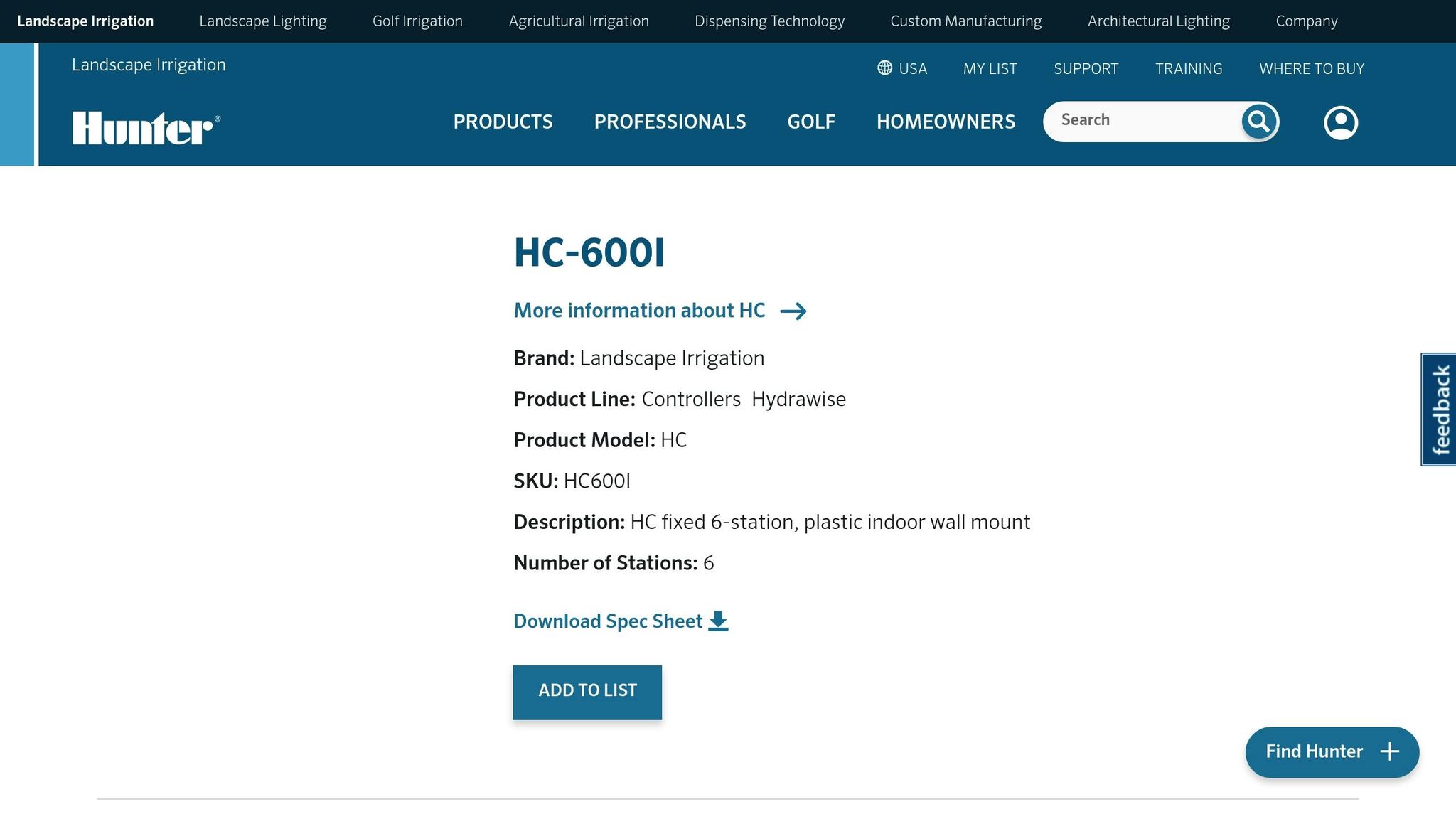
The Hunter HC-600i uses predictive watering technology to adjust schedules up to seven days in advance based on weather forecasts. Its modular design lets you start with a 4-zone system and expand up to 32 zones as needed. With a weatherproof casing and built-in lock, it’s ideal for outdoor installations. While its smart home integrations are more limited than some competitors, the rugged, professional-grade build makes it worth the $188 starting price.
RainMachine Touch HD Pro
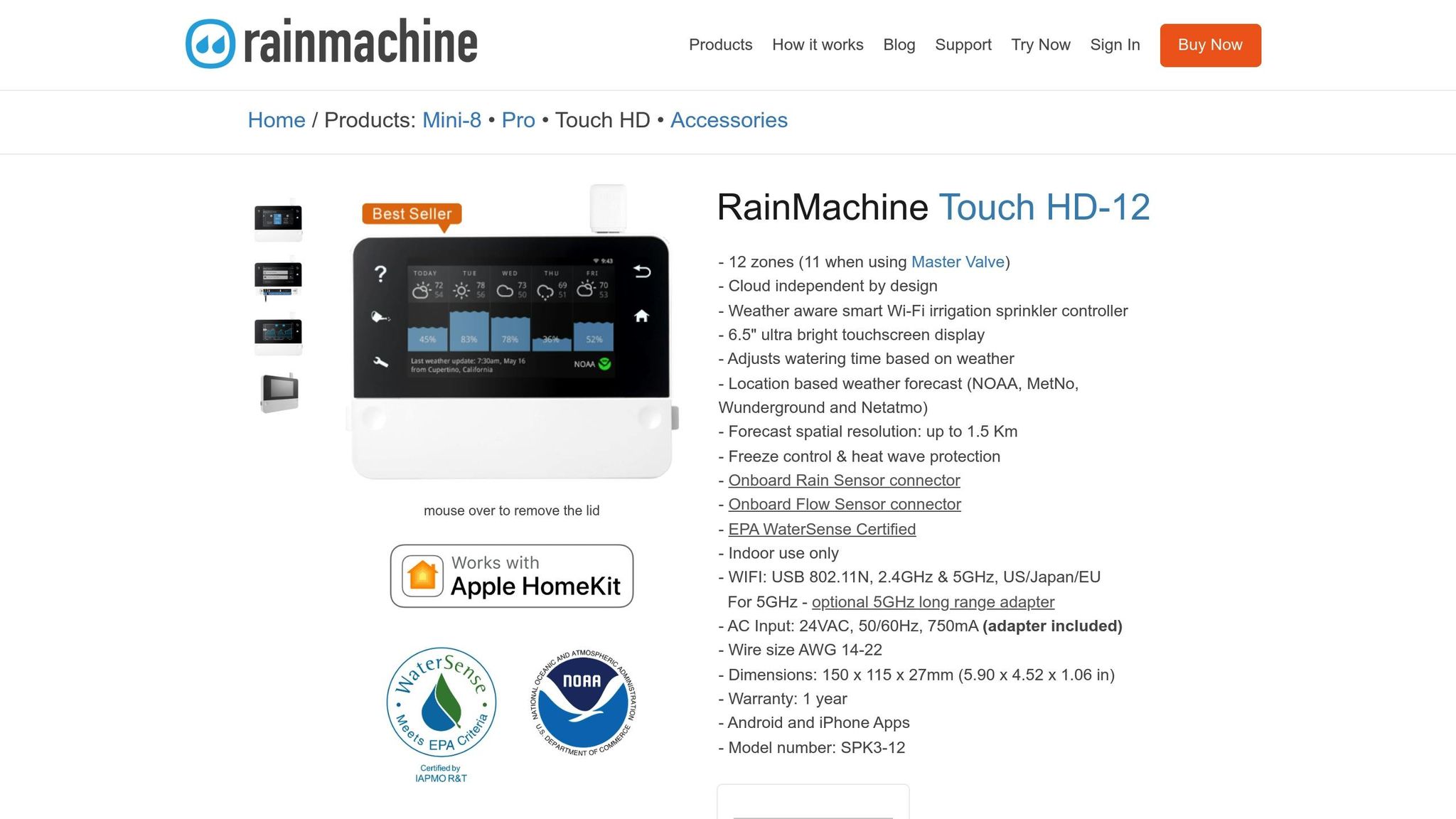
RainMachine Touch HD Pro operates independently of the internet, using open-source evapotranspiration calculations that users can customize. This transparency appeals to those who want control over their irrigation algorithms. The device features a 4.3-inch color touchscreen for direct management, alongside a mobile app for remote access. Unlike many systems, RainMachine doesn’t require subscription fees. While its self-adjusting schedules and water-saving features are praised, some users find the interface less intuitive. It holds a 3.4/5 star rating.
Spruce Smart Irrigation System
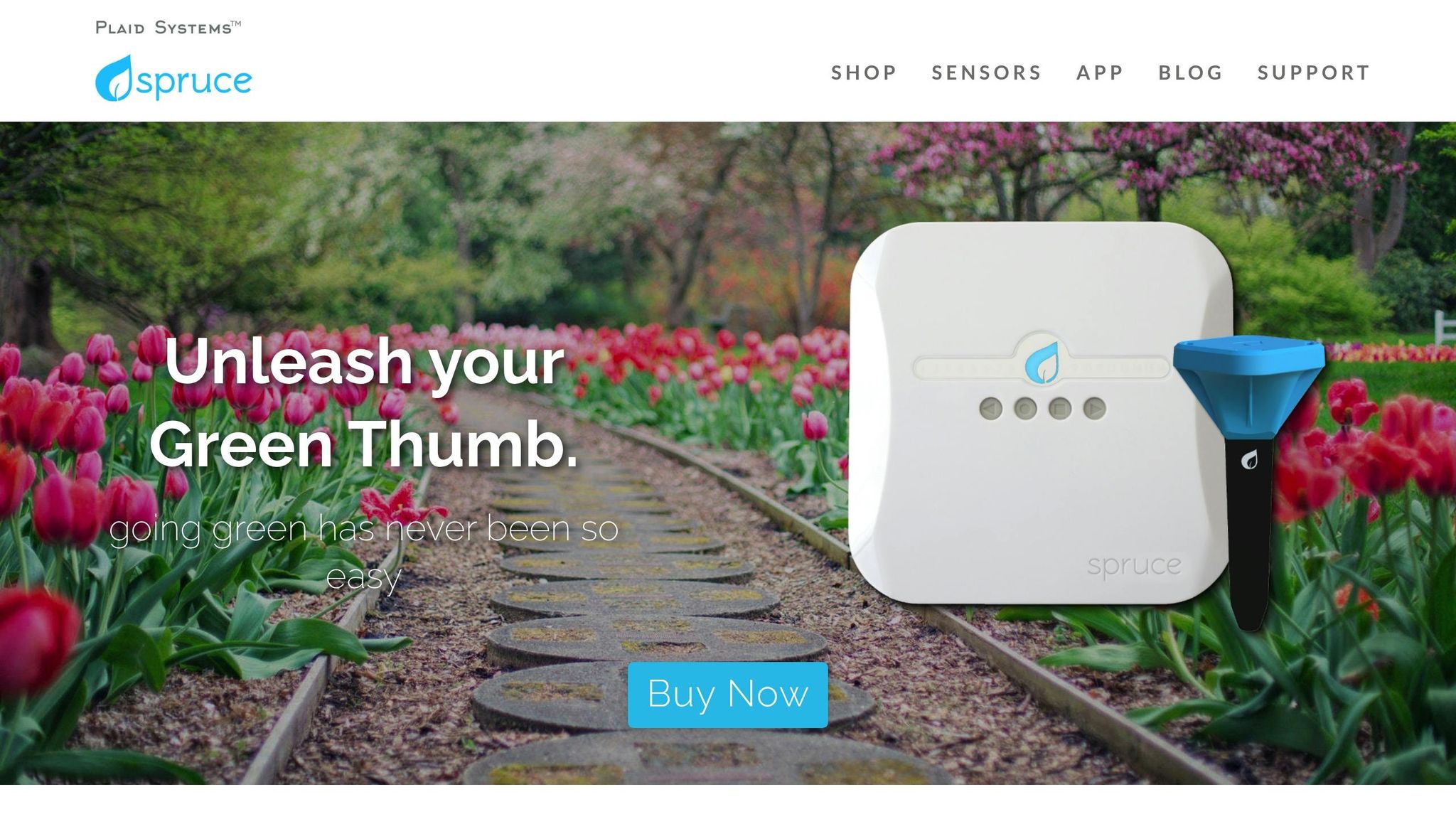
Spruce takes a different approach by using real-time soil moisture sensors connected via a Zigbee mesh network. Instead of relying solely on weather data, it gathers hyper-local soil information, making it particularly useful for microclimates or areas where regional weather data may not align with local conditions. This sensor-driven system is ideal for precision irrigation in high-value landscapes, where accurate soil moisture readings justify the investment in additional sensors.
Netro Sprite Smart Controller
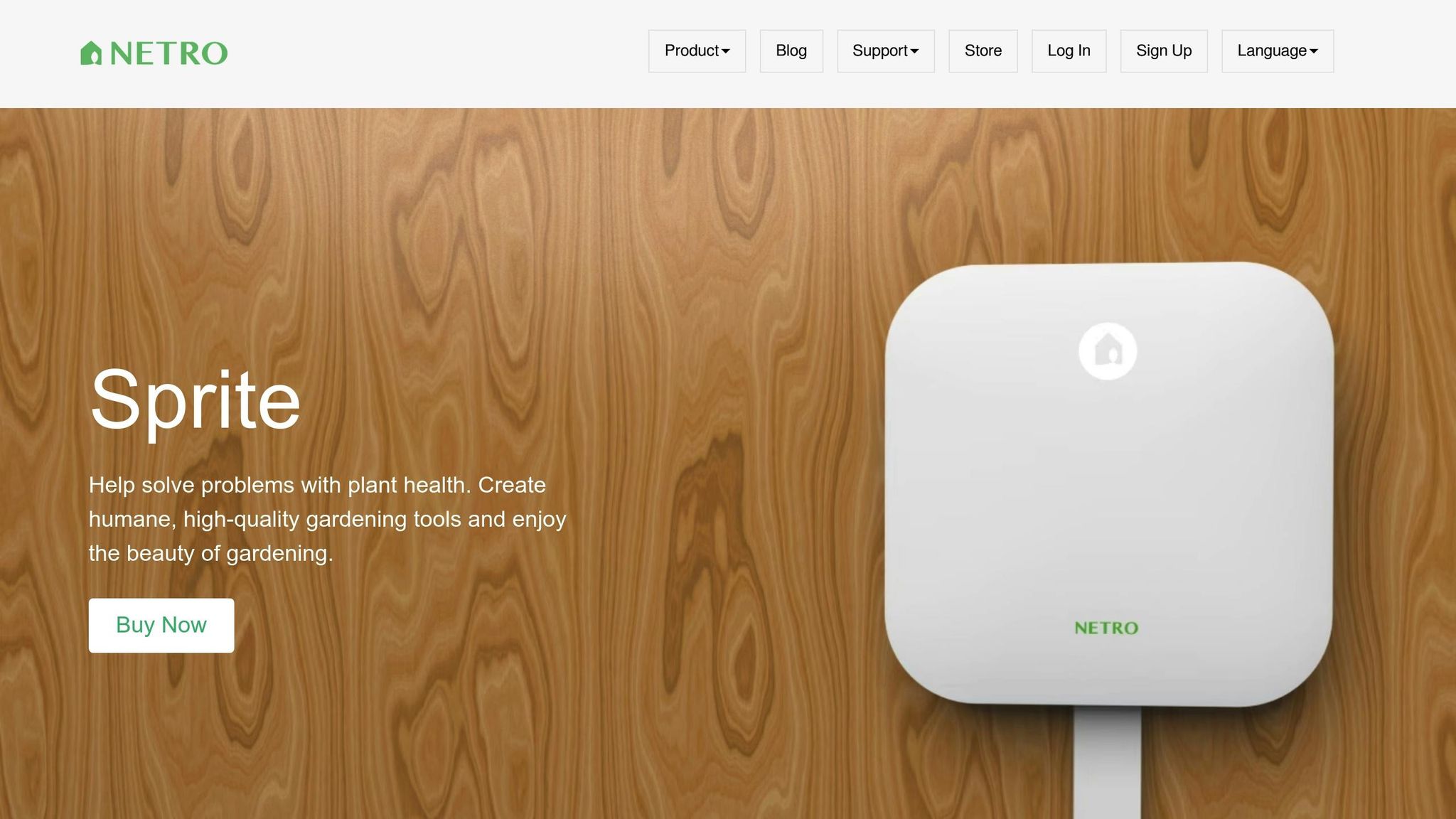
Netro Sprite stands out with plant-specific watering algorithms, tailoring irrigation to the unique needs of each zone rather than applying a one-size-fits-all approach. To ensure reliability, it pulls data from multiple weather APIs, so even if one service goes down, the system keeps running. With a 4.2/5 rating from over 1,300 customers, the Netro Sprite offers excellent value at $99 for the 6-zone model and $129 for the 12-zone version. Its plant-specific algorithms make it a smart choice for gardeners who want to optimize water use.
Rain Bird ARC8 Smart Controller

The Rain Bird ARC8 focuses on climate-responsive adjustments, excelling in freeze protection by automatically altering schedules based on temperature forecasts to prevent ice damage to irrigation systems. It includes a flow monitoring terminal compatible with Rain Bird’s flow sensors, providing comprehensive system oversight and leak detection. Known for its durable, professional-grade design, the ARC8 is a favorite among contractors and commercial users. While specific pricing isn’t listed, its advanced features make it a solid pick for those prioritizing reliability.
Orbit B-hyve XR Smart Timer

The Orbit B-hyve XR offers soil-type adaptive watering at a budget-friendly price, with the 16-zone model available for $160. It adjusts watering duration and frequency based on soil types - clay, loam, or sand - ensuring optimal water absorption and reducing runoff. For smaller systems, the 8-zone indoor controller is an affordable option at just $62. The system also integrates with Alexa and Google Home for voice control.
"Thank you @rachioco for making our lives easier with your controller. With this system, I no longer need to monitor the weather and the guesswork!" - Siddhi Gupta
While the initial app setup can be tricky, the system proves reliable once configured, offering a great entry point for homeowners seeking smart irrigation without breaking the bank.
sbb-itb-4d6a8dd
🚀 Ready to Reinvent Your Garden?
Join thousands of homeowners who have transformed their gardens using our AI design tool. Upload one photo to explore endless possibilities.
Get your AI garden designs →Comparison of the Top 7 Controllers
When it comes to irrigation controllers, each model brings its own strengths, tailored to different yard sizes, budgets, and specific needs. From zone capacity to water-saving technologies, there's a lot to consider. Here's a closer look at how the top models stack up.
Zone Capacity and Flexibility
Different controllers support varying numbers of zones, which can make a big difference depending on your property size. For example:
- Rachio 3: Available in 4, 8, or 16-zone models.
- Hunter HC-600i: Modular design supports anywhere from 4 to 32 zones.
- Netro Sprite: Offers 6 and 12-zone options.
- Orbit B-hyve XR: Comes in 8 and 16-zone models.
For larger properties, the Hunter HC-600i stands out with its modular expandability, handling up to 32 zones. Meanwhile, the Rachio 3 offers flexibility across its models but lacks the ability to expand beyond its fixed zone capacities.
Water-Saving Features
Smart irrigation systems can reduce water usage by up to 30%. A controller with a WaterSense label and weather-based adjustments could save nearly 7,600 gallons of water annually. Here's how some of the top models tackle water conservation:
- Rachio 3: Uses advanced weather intelligence to adjust watering schedules based on local conditions.
- RainMachine Touch HD Pro: Incorporates real-time climate data for precise watering.
- Spruce Smart: Relies on soil moisture sensors for hyper-localized readings.
- Orbit B-hyve XR: Offers weather-based scheduling and optional soil moisture sensor integration for added precision.
As Consumer Reports test engineer Larry Ciufo explains:
"The ability of these smart sprinkler controllers to make fine-tuned watering adjustments greatly depends on the robustness of their weather data. You're going to want a controller that uses a lot of forecast data to make its adjustments."
Pricing Overview
Prices vary based on features and target audiences. Here's a snapshot of starting prices for some popular models:
- Rachio 3: Around $199 for the 8-zone version and $250 for the 16-zone model.
- Hunter HC-600i: Starts at $188 but requires additional investment for expansion modules.
- Orbit B-hyve XR: Roughly $160 for the 16-zone version, making it a more budget-friendly option.
Comparison Table
| Controller | Zone Options | Starting Price | Key Strength | Water-Saving Feature |
|---|---|---|---|---|
| Rachio 3 | 4, 8, 16 zones | $199 (8-zone) | Weather intelligence & flow monitoring | Advanced weather adjustments |
| Hunter HC-600i | 4–32 zones (modular) | $188 | Professional-grade durability | 7-day predictive watering |
| RainMachine Touch HD Pro | Multiple options | Not specified | Internet-independent operation | Customizable evapotranspiration |
| Spruce Smart | Varies | Not specified | Integrated soil moisture sensing | Localized moisture data |
| Netro Sprite | 6, 12 zones | ~$150 (6-zone) | Plant-specific algorithms | Multiple weather API sources |
| Rain Bird ARC8 | 8 zones | Not specified | Freeze protection | Climate-responsive adjustments |
| Orbit B-hyve XR | 8, 16 zones | $160 (16-zone) | Budget-friendly smart features | Soil-type adaptive watering |
Additional Features and Considerations
Controllers also differ in their approach to integration and ease of use:
- Sensor Integration: The Spruce Smart system uses soil moisture sensors for precise irrigation, while the Orbit B-hyve XR combines weather-based scheduling with optional moisture sensors for added flexibility.
- User Experience: The Rachio 3 is praised for its intuitive app, making it accessible for beginners while still offering features that meet professional standards.
- Durability: Models like the Hunter HC-600i are built for rugged, professional-grade applications, while others focus on ease of setup for residential users.
These differences highlight how each controller caters to specific needs, from small residential yards to expansive commercial properties. Whether you're prioritizing advanced weather intelligence, modular expandability, or affordability, there's a controller designed to fit your goals.
Conclusion and Recommendations
To wrap up our review, these irrigation controllers combine smart automation with water-saving features, making them a practical choice for both residential and commercial use. With cloud connectivity, they can reduce outdoor water usage by 20%–50%, translating into significant cost savings.
The seven controllers we've discussed cater to various needs and budgets. For those watching their spending, the Orbit B-hyve Smart Indoor Irrigation Controller offers essential smart features for just $62–$63. If you're looking for a balance between advanced functionality and affordability, the Orbit B-hyve XR provides excellent value at around $160 for 16 zones, although its app interface can be a bit tricky to navigate.
For homeowners seeking a premium experience, the Rachio 3 stands out as the top choice despite its $199 price tag for 8 zones. As one Home & Garden Tech Editor put it, "Rachio 3 is unrivaled in app experience and weather smart scheduling". Its intuitive interface and superior weather-based scheduling make it worth the investment for many.
On the professional side, landscapers and those managing larger properties will find the Hunter Hydrawise HC-600i invaluable. Starting at $188, it offers modular scalability from 4 to 32 zones, making it perfect for businesses or complex setups that may expand over time.
Research shows the effectiveness of smart irrigation tools. For example, a study in Northwest Arkansas found rain sensors reduced annual water use by 22.1%, while soil moisture sensors achieved an impressive 66.2% savings. These tools also delivered strong returns on investment, estimated at 87% and 200%, respectively.
These systems go beyond just saving water. They allow for remote access, enabling quick adjustments, easier troubleshooting, and real-time monitoring from virtually anywhere. Whether you're managing a backyard garden or a sprawling commercial property, these features make irrigation more efficient and hassle-free.
When choosing a controller, think about your specific needs - how many zones you need to manage, your budget, and features like weather-based adjustments or soil moisture sensing. Smart irrigation controllers are a key tool for keeping your plants healthy while cutting down on water waste and expenses.
For those interested in a holistic approach to landscaping, tools like AIGardenPlanner can help you design layouts that maximize water efficiency. By pairing these smart controllers with thoughtful garden planning, you can ensure your plants thrive with optimal water distribution and minimal effort.
FAQs
How do smart irrigation controllers use weather data to save water and improve efficiency?
Smart irrigation controllers, often called weather-based controllers, take the guesswork out of watering by using real-time weather data and soil conditions to adjust schedules automatically. These systems analyze key factors like rainfall, temperature, and evaporation rates to deliver just the right amount of water - preventing both overwatering and waste.
For instance, they can halt watering during rainy periods or increase it during particularly dry spells. Some advanced models go a step further, using sensors and algorithms to determine the best watering times and amounts for specific plants. The result? Healthier landscapes, lower water bills, and a step toward more sustainable gardening practices.
What are the advantages of using a smart irrigation controller with soil moisture sensors instead of one that only relies on weather data?
Smart irrigation controllers equipped with soil moisture sensors bring some clear advantages over those that rely only on weather data.
These sensors keep tabs on soil moisture levels in real time, ensuring water is applied only when your plants need it. This targeted approach can cut water usage by 20% to 50%, saving both resources and money on utility bills. On the other hand, weather-based systems rely on forecasts, which might not match the actual conditions in your soil, leading to either overwatering or underwatering.
Another perk? Soil moisture sensors help your plants thrive by delivering water right to the root zone when it’s truly needed. This encourages stronger growth, better drought tolerance, and lowers the chance of plant diseases. For anyone aiming for efficient and environmentally friendly irrigation, soil moisture-based controllers are a smart and dependable option.
Can I add more zones to my irrigation controller if my yard or garden expands?
Many cloud-connected irrigation controllers are built to accommodate the changing needs of your landscaping. They often include expansion modules, which let you increase the number of zones your system can manage. Depending on the model, you can usually add anywhere from 4 to 16 extra zones. This makes it easy to scale your system as your garden or yard grows, offering a practical, long-term approach to efficient watering.
Related posts
Related Articles

AI Data Analytics for Climate-Resilient Gardens
Explore how AI data analytics can enhance gardening practices, from pest management to resource optimization, for climate-resilient gardens.

Checklist for Zen Garden Structure Maintenance
Explore essential maintenance tasks to preserve the serene beauty of your Zen garden, ensuring its tranquility and vibrant health.
Elevate Your Outdoor Space with Modern Rock Garden Ideas
Discover innovative concepts and practical tips for designing a modern rock garden that combines nature with contemporary design. Explore rock types, plant selection, focal points, water features, lighting ideas, and maintenance tips.
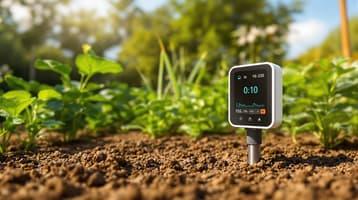
Ultimate Guide to AI-Powered Soil Monitoring
Learn how AI-powered soil monitoring transforms gardening with real-time insights for healthier soil and more efficient resource use.
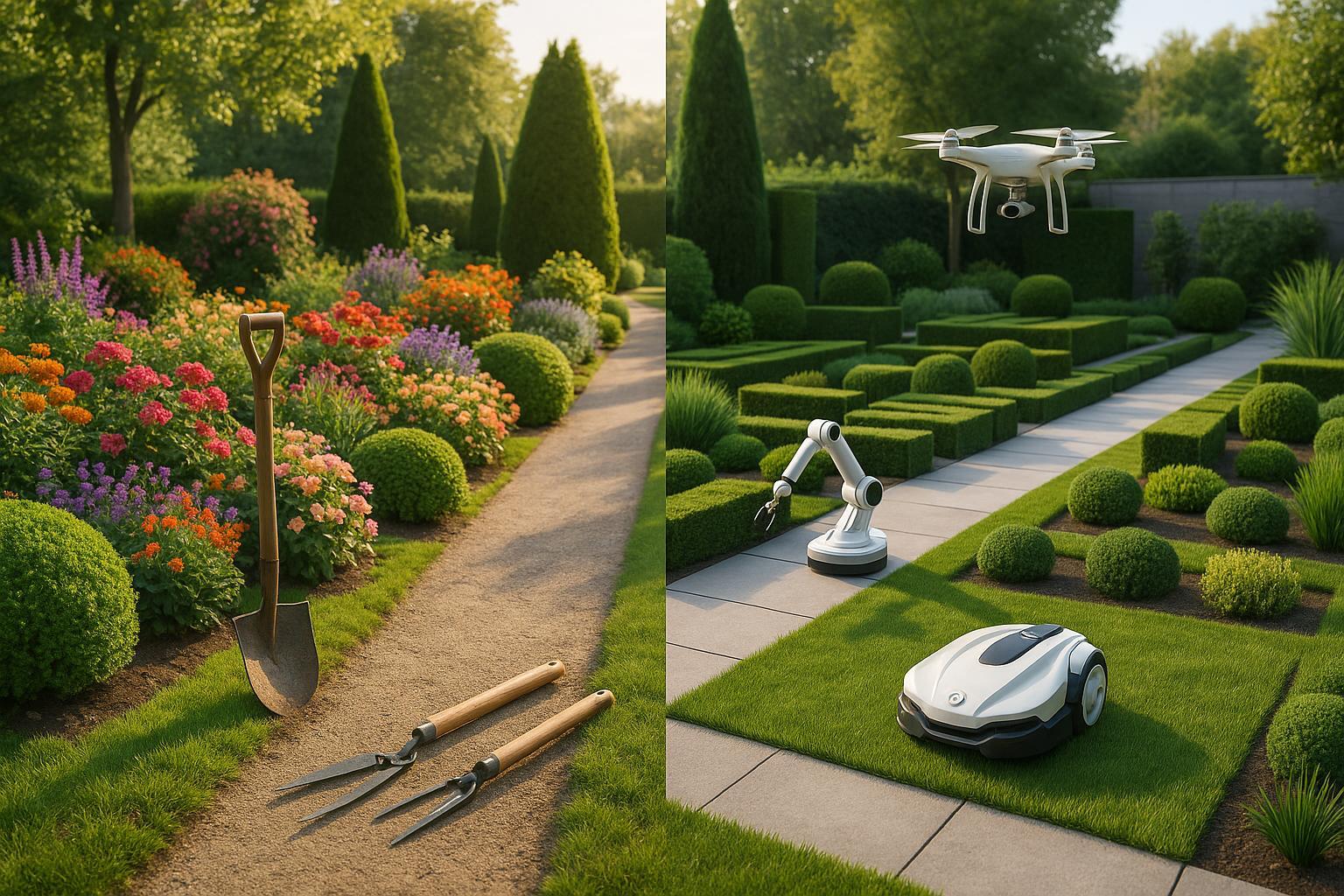
AI vs. Traditional Methods for Garden Restoration
Explore the advantages and challenges of AI-powered tools versus traditional methods in garden restoration to find the best approach for your project.
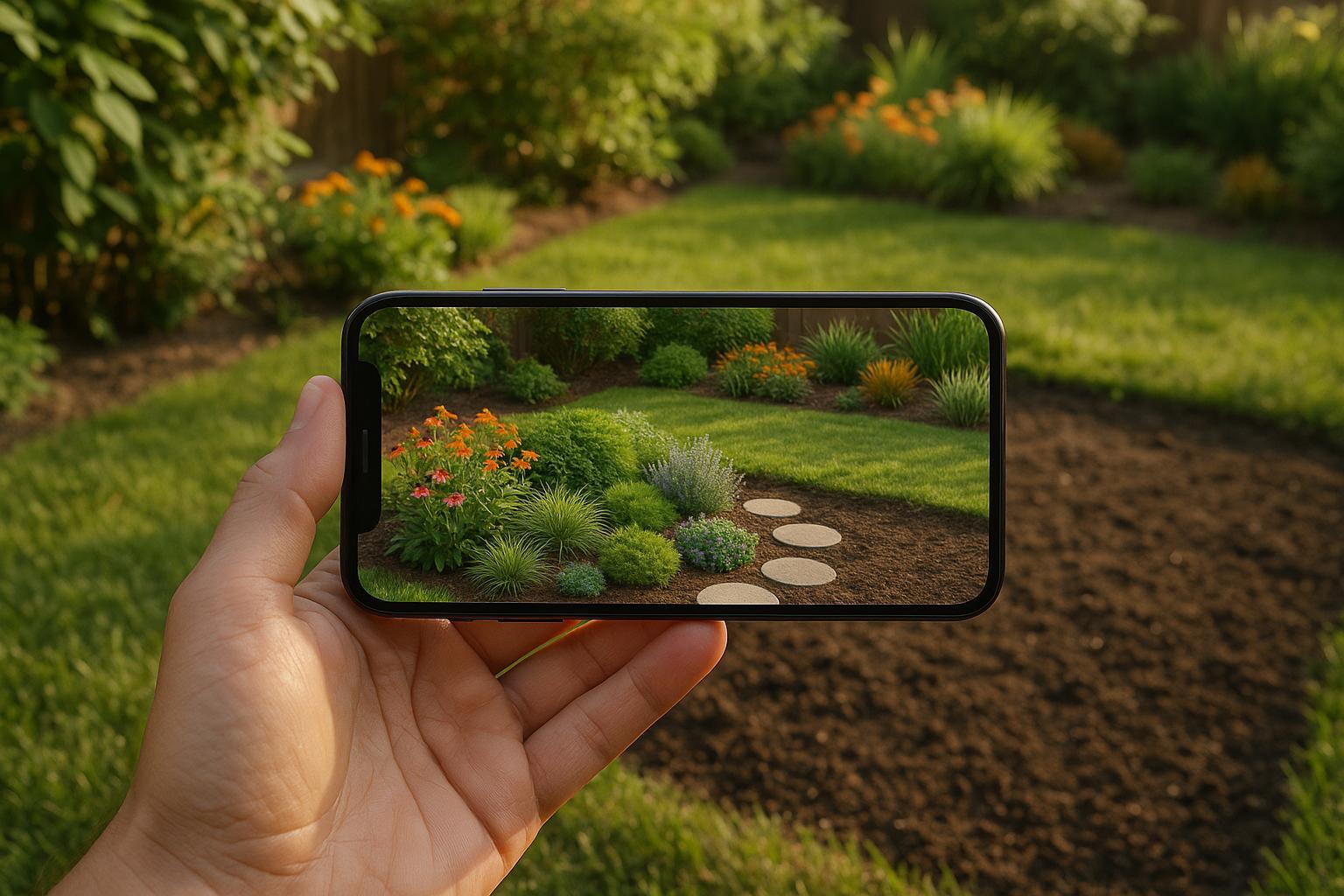
How AR Previews Transform Garden Planning
Explore how Augmented Reality is revolutionizing garden planning with real-time visuals, precise measurements, and personalized plant guidance.